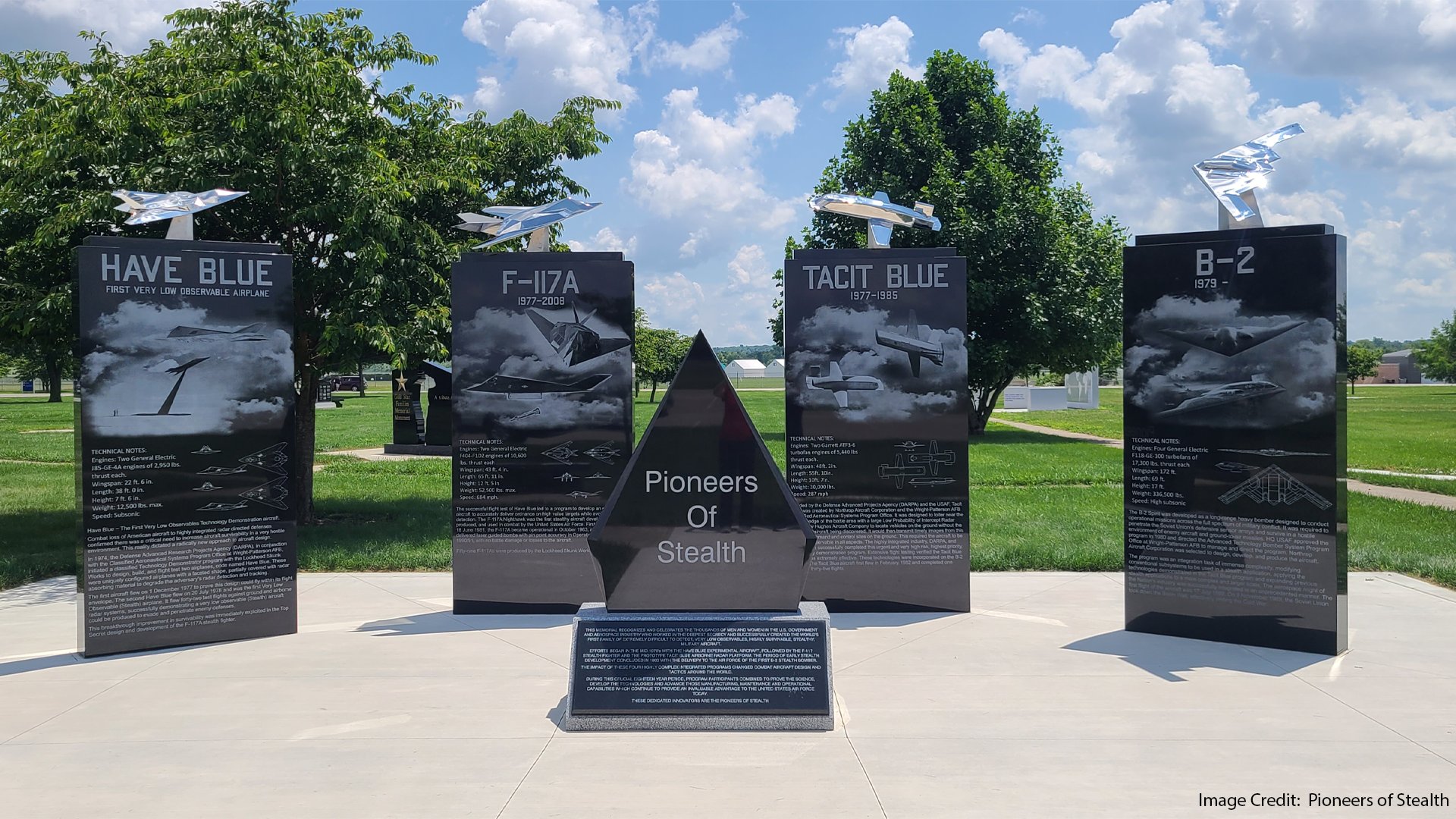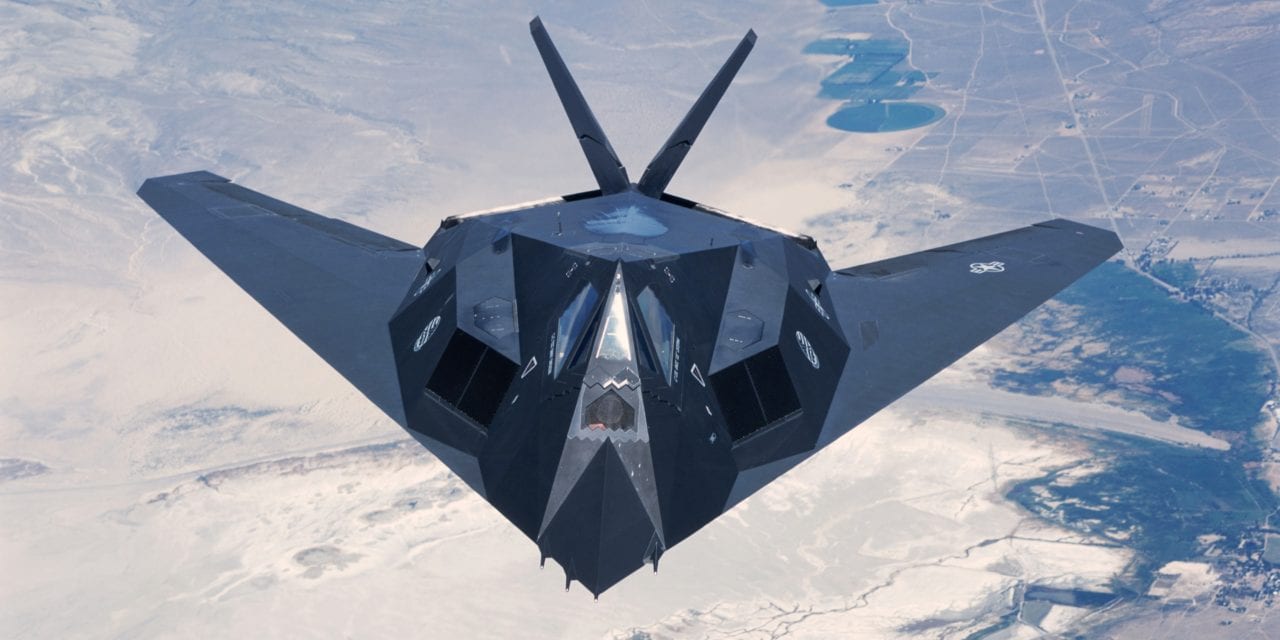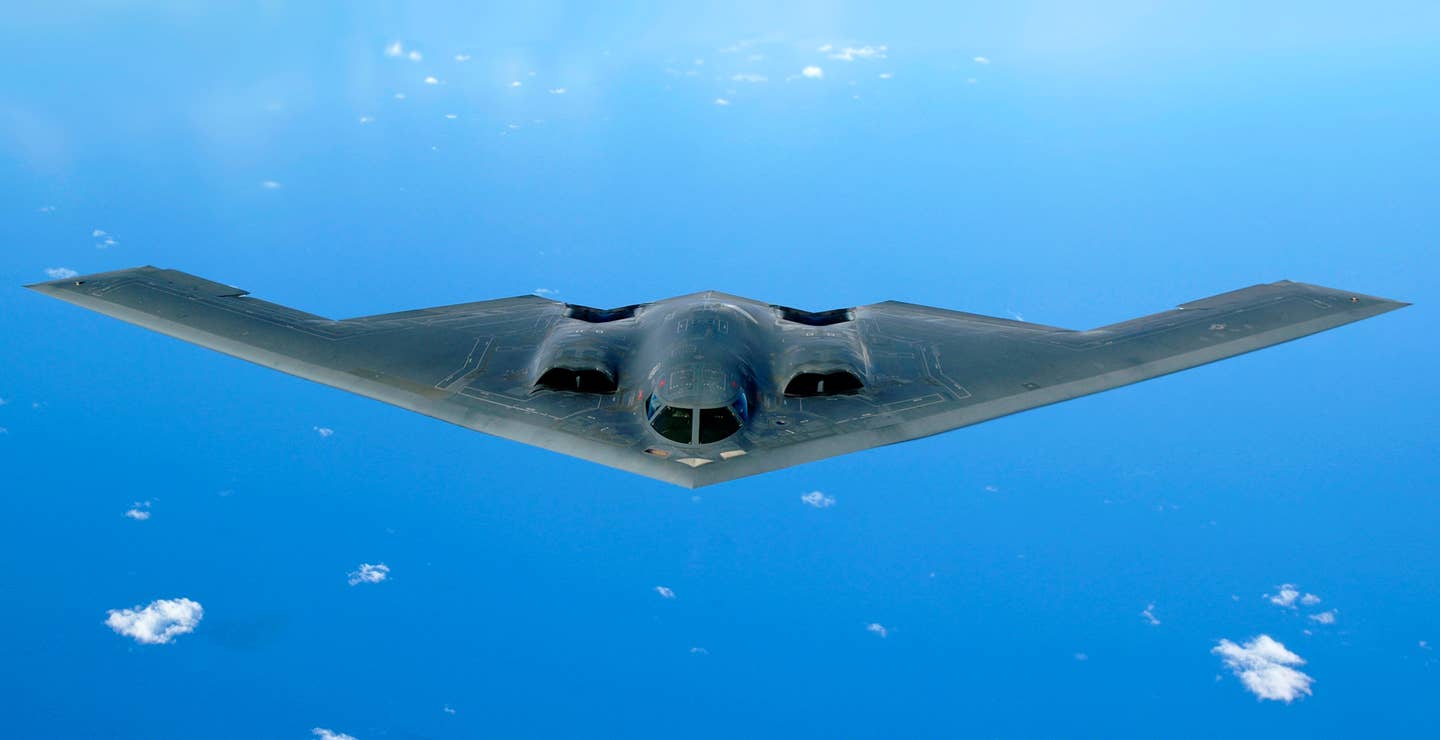A memorial was recently unveiled at the National Museum of the United States Air Force Memorial Park in Ohio, paying tribute to those who developed the US Air Force’s pioneering stealth aircraft.
Aptly named the ‘Pioneers of Stealth’ memorial, it features four towering obelisks, symbolizing key programs that played a pivotal role in the genesis of stealth technology, tracing its origins back to the 1970s.
Among the notable aircraft commemorated are Lockheed’s Have Blue, which laid the foundation for the renowned F-117A Nighthawk, and Northrop Grumman’s Tacit Blue ‘Whale,’ instrumental in creating the B-2 Spirit.
The early efforts invested in these programs, along with other covert initiatives that extend even further into history, resulted in a monumental transformation of aerial warfare. The four programs showcased in this memorial were once shrouded in utmost secrecy, far beyond public knowledge.
A special two-day event took place from July 16 to July 17 to reveal the memorial to the public.
Notably, July 17 held a double significance as it commemorated the 34th anniversary of the maiden flight of the renowned B-2 Spirit stealth bomber and the official unveiling of the memorial.

The conceptualization and design of this memorial were spearheaded by “The Pioneers of Stealth,” a group comprising more than 200 individuals hailing from the US government and defense industry.
With their extensive involvement in the development of stealth technology since the latter part of the twentieth century, they have played an important role in shaping the landscape of modern warfare.
The fact that the information about these stealth aircraft programs is now exhibited in a public space reflects the remarkable progress and recognition bestowed upon the innovators who pioneered these groundbreaking advancements.
The memorial measures 30 ft by 30 ft with a height restriction of 10 ft as per National Museum of the USAF (NMUSAF) requirements. It features a triangular dedication obelisk at the front and four granite obelisks at the rear, arranged chronologically (Have Blue, F-117A, Tacit Blue, and B-2) to symbolize the advancement of stealth technology.
The black granite alludes to the color associated with stealth aircraft and their classified origins.
On the 34th anniversary of the B-2 Spirit’s first flight, we recognize the dedicated teams behind this #engineering marvel.
Discover our legacy in stealth aircraft & how our pioneers are honored at the National Museum of the @usairforce Memorial Park.
https://t.co/ySEcJzIhzU pic.twitter.com/eCTlXAYeUP
— Northrop Grumman (@northropgrumman) July 17, 2023
The memorial also showcases polished stainless steel models of the four aircraft, mounted on the rear obelisks via pylons resembling those used in radar cross-section testing.
The models are not to scale but serve as representative symbols. The Tacit Blue model is 30 inches long with a 22-inch wingspan, the B-2 is 22 inches long with a 41-inch wingspan, the Have Blue is 31 inches long with a 16-inch wingspan, and the F-117A is 37 inches long with a 24-inch wingspan.
Evolution Of Stealth Technology
Stealth technology has revolutionized aircraft design, enabling them to penetrate enemy airspace undetected and evade potential threats by significantly reducing their radar cross section and often their infrared signature.
This technological advancement allows aircraft to operate covertly and execute strategic missions with minimal risk of detection or interception.
The origins of stealth can be traced back to experimental aircraft in the 1940s, particularly the iconic YB-49 flying wing conceptualized by visionary Jack Northrop.
The YB-49, distinguished by its smooth surfaces, rounded edges, and unique all-wing structure devoid of a conventional tail or fuselage, possessed a small radar footprint. But during that era, the significance of this feature was largely overlooked, leading to the cancellation of the YB-49 project in 1949.
In a lesser-known technical paper published in the 1960s, Russian physicist Pyotr Ufimtsev presented a theory. Ufimtsev postulated that if we carefully calculate how electromagnetic waves bounce off a flat surface, we can estimate their reflection on the radar.
However, his findings were disregarded by the scientific community, including his compatriots in Russia, failing to grasp his research’s immense potential and implications.
In the 1970s, bombers, and fighters faced mounting threats from radar-controlled air defenses, leaving them increasingly susceptible to detection.
Recognizing the need for a solution, the Defense Advanced Research Projects Agency (DARPA) and the US Air Force initiated a collaborative project to develop combat aircraft designed to have exceptionally low radar signatures.
Lockheed Martin and Northrop were awarded contracts in 1975. Their task was to construct static models for the Experimental Survivable Testbed (XST), a crucial research initiative to explore the feasibility of aircraft with low radar signatures.
Lockheed and Northrop took different approaches to stealth development. Lockheed utilized a computer program called “Echo 1” based on previously mentioned Russian scientist Ufimtsev’s calculations, while Northrop focused on shaping and compound curves.
The XST models developed by both companies underwent testing by being mounted on poles and exposed to electromagnetic waves to evaluate and compare their radar cross-sections. However, Lockheed’s model proved superior in radar cross-section evaluations, leading to their selection in 1976.
Meanwhile, DARPA awarded Northrop a separate contract in 1978 to develop the stealthy Battlefield Surveillance Aircraft (BSAX) as part of the broader “Assault Breaker” program. BSAX aimed to operate near the front lines during a potential tank attack in Europe.
Following the XST pole tests, Lockheed introduced “Have Blue,” their manned technology demonstrator, for flight testing in April 1977.
Have Blue was a compact single-engine aircraft with a sleek design featuring swept wings and distinct planar surfaces. It effectively scattered incoming radar beams by employing facets set at unconventional angles. The company developed two demonstrators.
Despite the unfortunate crashes of both Have Blue demonstrators, the research and progress made during their development played a crucial role in shaping the F-117’s advancement.
The F-117, which conducted its first flight in 1981 and became operational in 1983, was eventually retired in 2008. Nevertheless, the service has retained a few of these aircraft for various purposes.

Although technically an attack aircraft designed for bombing missions rather than aerial combat, it was designated as an “F” (fighter) rather than an “A” (attack) to attract top pilots.
On the other hand, Northrop introduced their BSAX demonstrator, “Tacit Blue,” which flew for the first time in February 1982. Tacit Blue’s peculiar appearance made it one of the most unconventional aircraft ever built.
It had a box-like structure with low-observable features incorporated into its design, often described as resembling a butter dish with wings. Tacit Blue underwent 135 test flights between 1982 and 1985, bolstering confidence in Northrop’s approach to stealth.
The distinctive curved design of Tacit Blue had a lasting impact, influencing the design of subsequent aircraft such as the YF-23 and the B-2 Spirit. However, only 21 B-2 Spirit aircraft were produced between the late 1980s and 2000.

The advancement in stealth technology continued with the introduction of the Lockheed Martin F-22 Raptor, an air-to-air fighter aircraft that made its first flight in 1997.
The F-22’s radar cross section is often likened to that of a golf ball or a bumblebee, highlighting its exceptional stealth capabilities. Following the F-22, the Lockheed Martin F-35 Joint Strike Fighter took flight in 2006.
Designed for both aerial combat and ground attack, the F-35 is a single-engine aircraft. Technological improvements have allowed the new generation of stealth aircraft to overcome some of the limitations of their predecessors.
They offer supersonic speeds, with the F-22 capable of reaching Mach 2 and the F-35 achieving Mach 1.6. Originally, the Air Force planned to procure 750 F-22s. However, the F-22 program was terminated with a total of 187 aircraft produced.
Looking ahead, the Northrop Grumman B-21 Raider is set to succeed the B-2. This next-generation bomber resembles its predecessor, the B-2, reflecting a strong family resemblance in its design.
- Contact the author at ashishmichel(at)gmail.com
- Follow EurAsian Times on Google News




